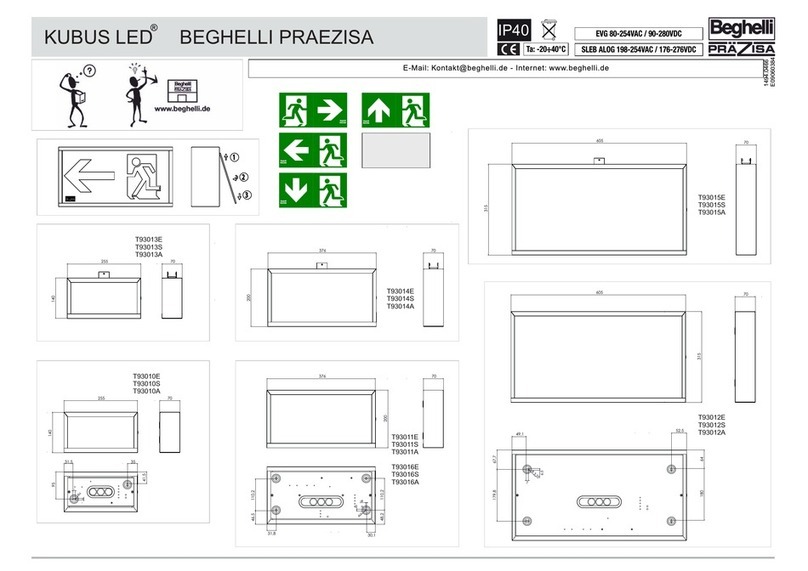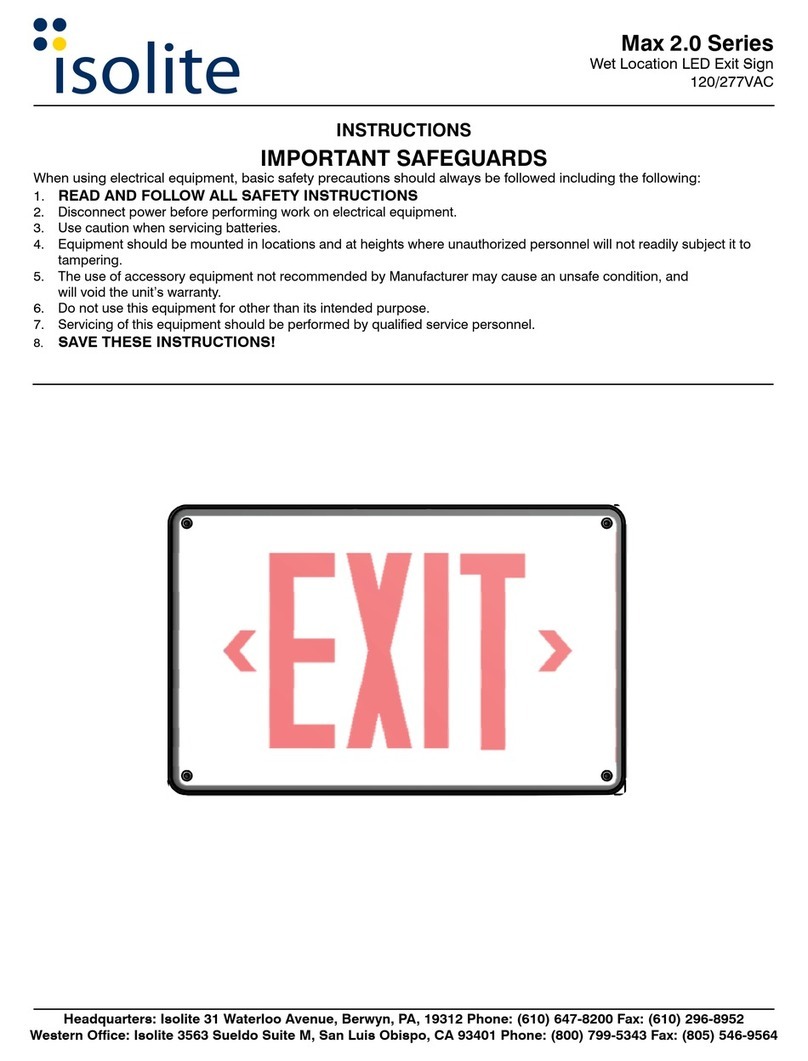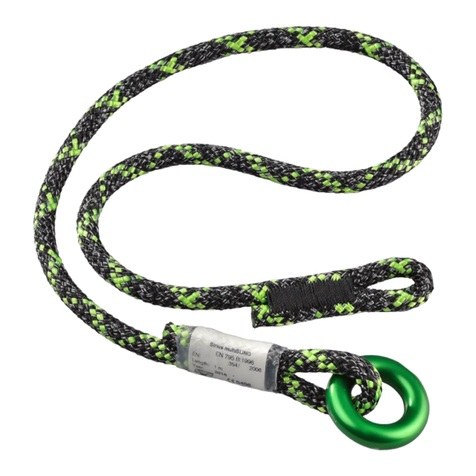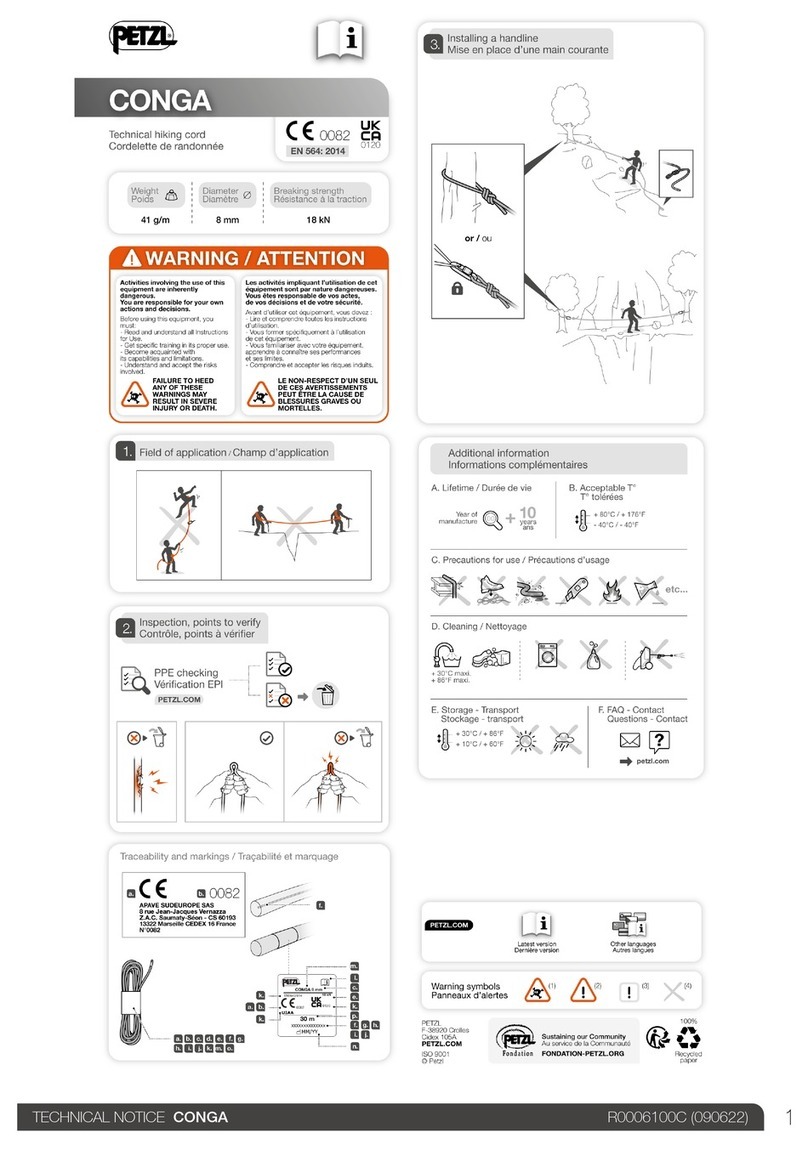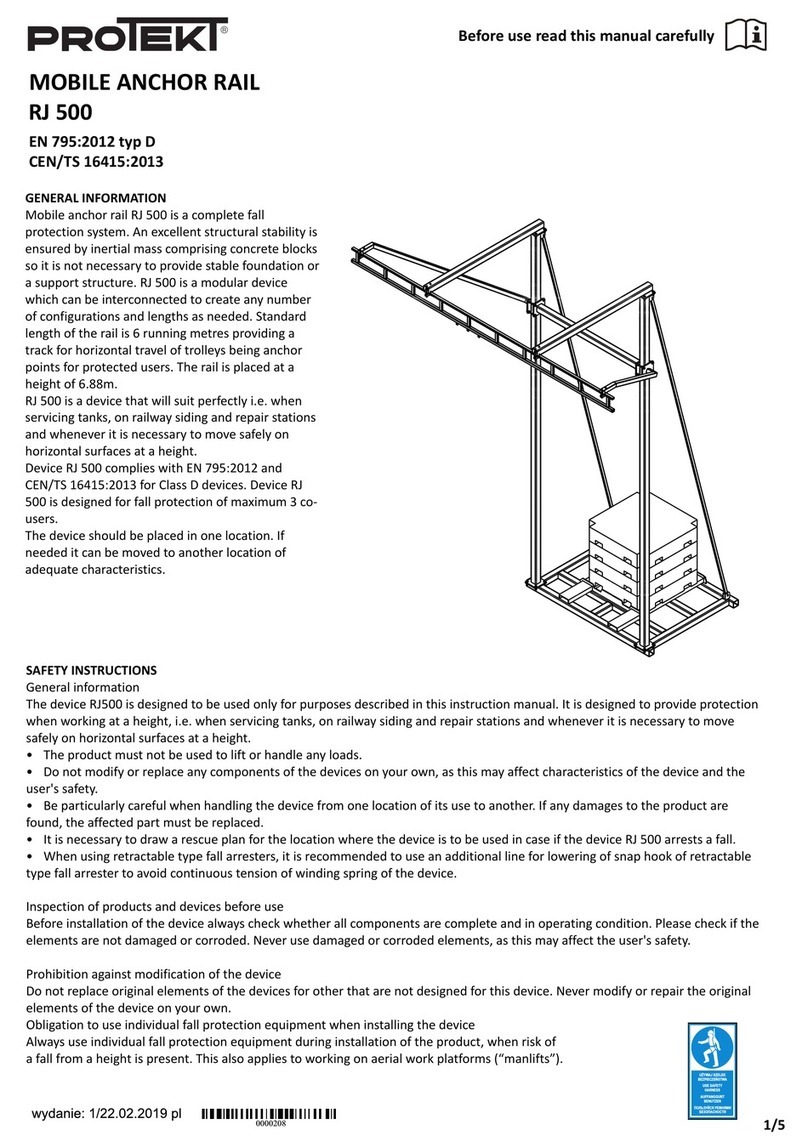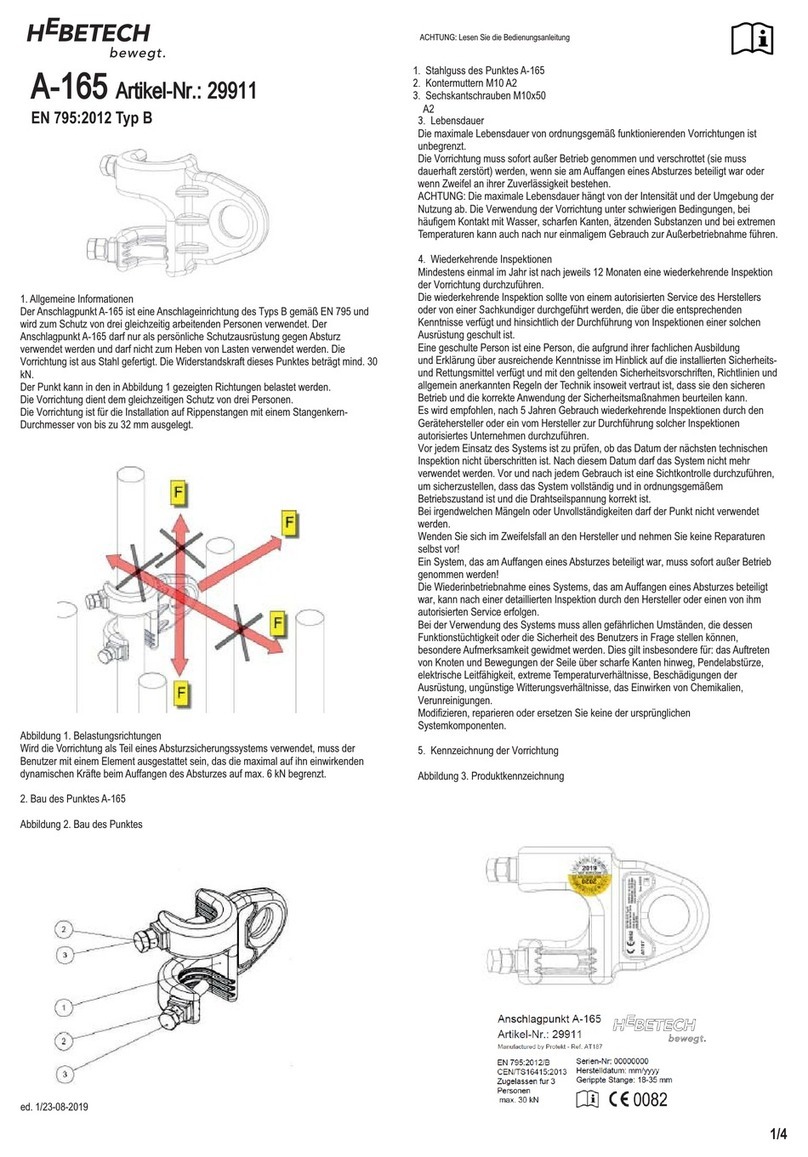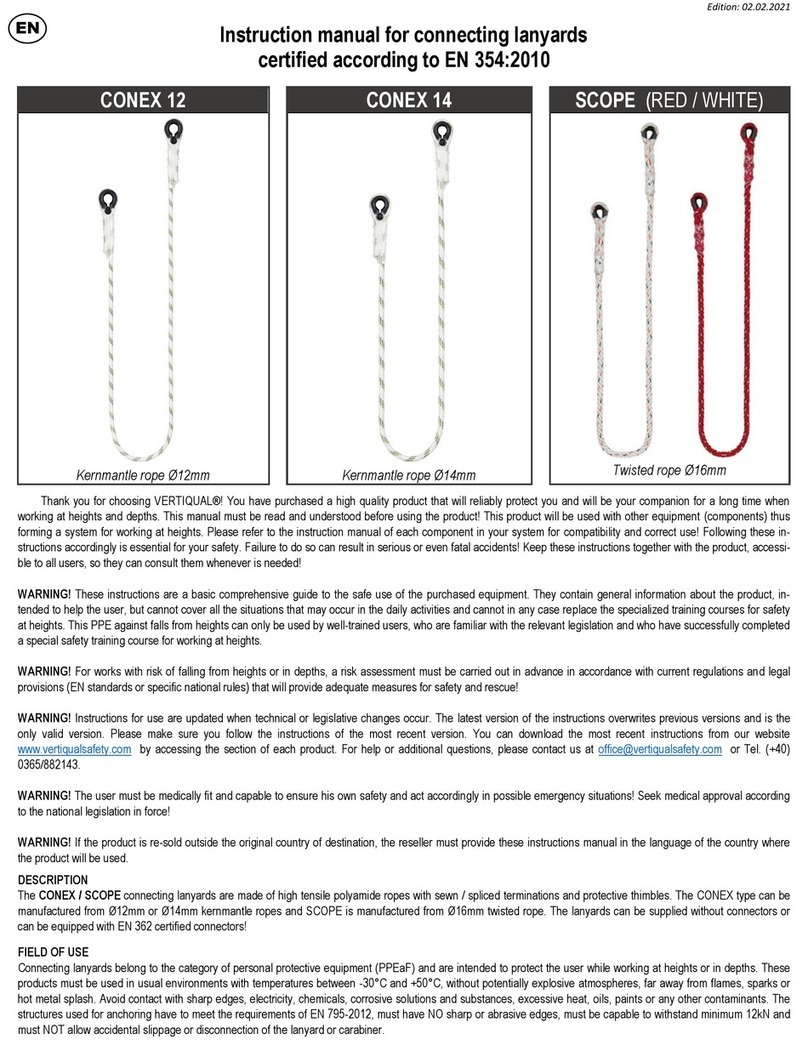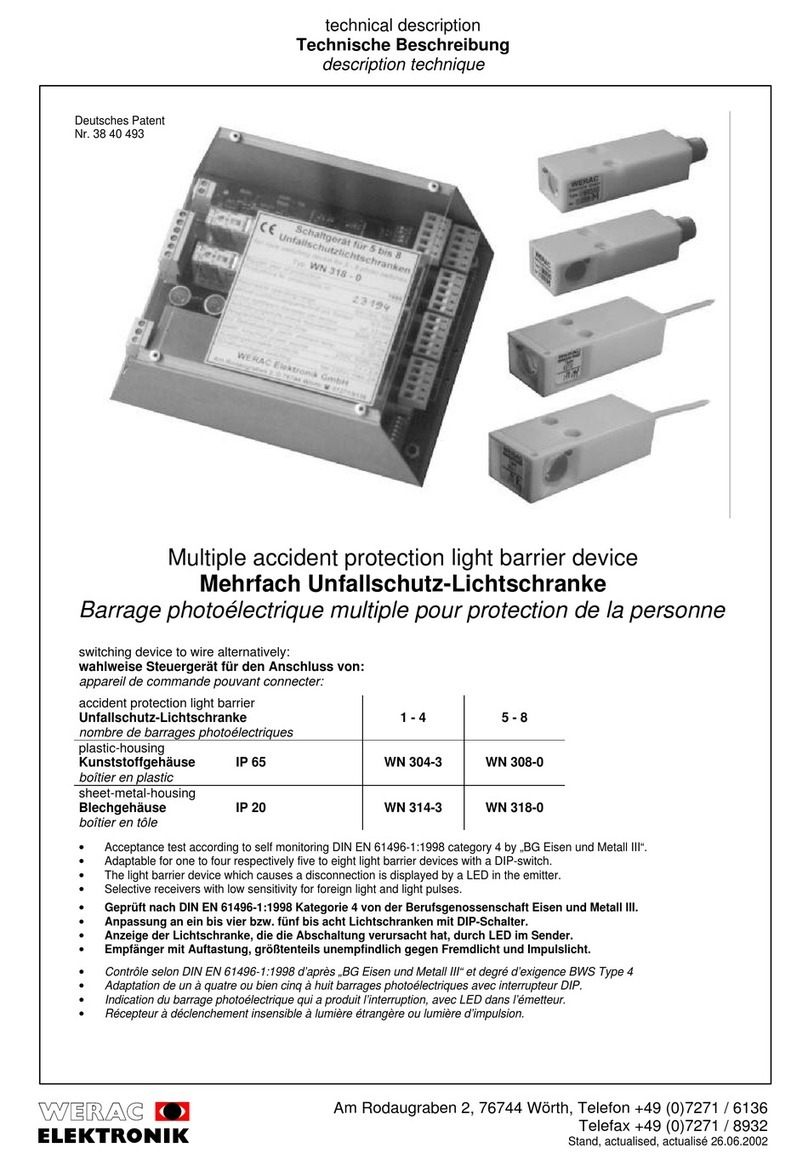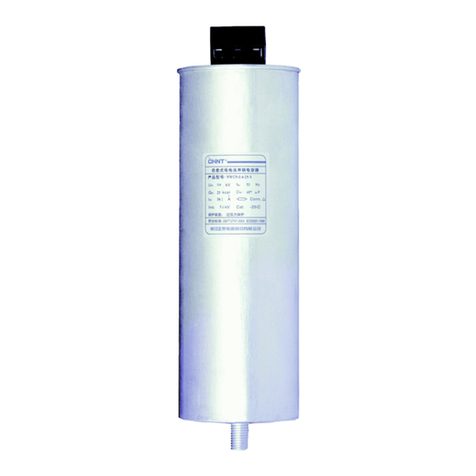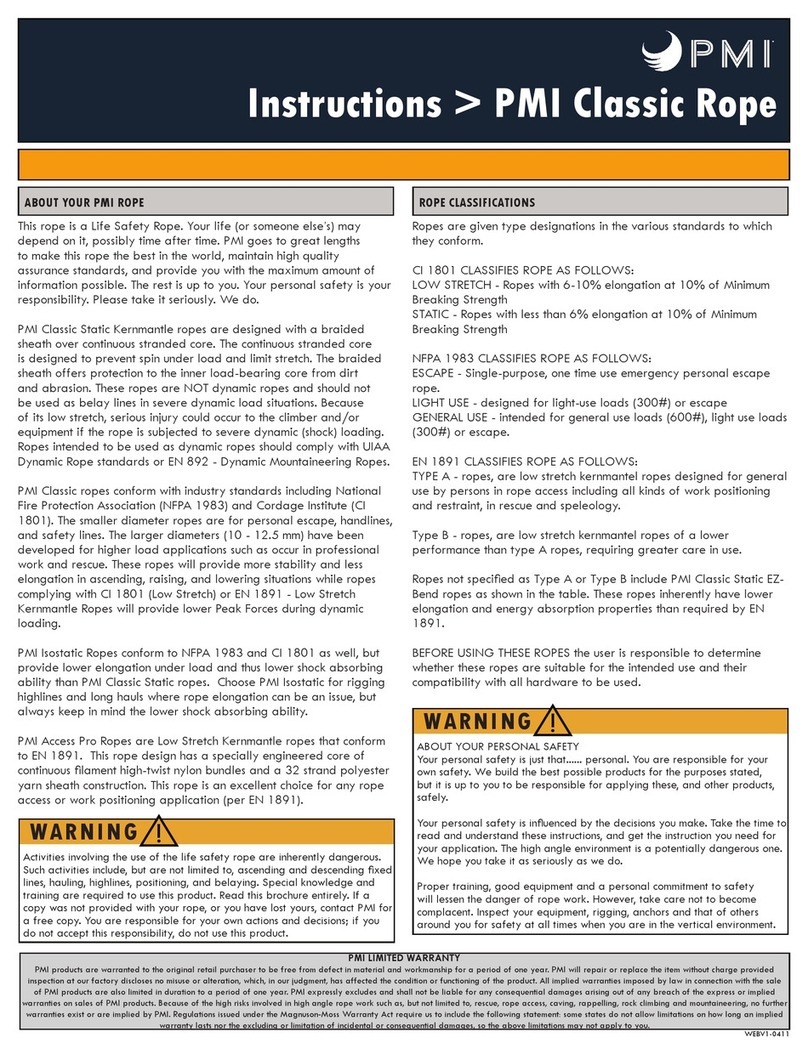Femsa NFPA 1951 Owner's manual

PROTECTIVE GARMENTS
FOR URBAN SEARCH AND RESCUE OPERATIONS
2010
FEMSA
OFFiciAl
USEr
inFOrMAtiOn
GUidE
! DANGER
• Do not use your Protective Garment
untilyouhavereadandunderstoodall
labelsonyourProtectiveElementsand
thisOfcialUserInformationGuide.
• Onlyendusershallseparatethisguide
fromtheelement.Removeguidefrom
theelementpriortousingtheelement
foremergencyoperations.
Fire and Emergency Manufacturers
and Services Association, Inc.
www.femsa.org
Untitled-1 1 12/17/10 11:43 AM

©2003 (Guide Reprinted 2010)
Fire and Emergency Manufacturers
and Services Association, Inc.
PO Box 147
Lynneld, MA 01940-1047
www.femsa.org
All rights reserved. No part of the material protected by this copyright notice may be reproduced, copied, paraphrased, or utilized in any form or by any means,
electronic or mechanical, including photocopying, recording, or by any information storage and retrieval system, without the prior written permission of the
copyright owner.
Read this guide and all labels before using your protective ensemble. Review this guide on a regular basis.
FEMSA acknowledges with thanks the input of the re service in developing, reviewing and rening this work (especially the ne work of CAFER, NAFER,
SAFER & FIERO on their “PPE Care & Use Guidelines”).
#USAR100G
Untitled-1 2 12/17/10 11:43 AM

FEMSA Official User Information
Guide
Protective Garments for
Urban Search and Rescue Operations
Untitled-1 3 12/17/10 11:43 AM

Chapter 1: Introduction ..................................................................1-1
How To Reduce Your Risk ...................................................................................1-1
Training By Your Fire Department Or Employer .................................................1-1
Chapter 2: Signal Words and Denitions .....................................2-1
Alarm time ........................................................................................................... 2-1
Approach Fire Fighting ........................................................................................ 2-1
Barrier Layer ......................................................................................................... 2-1
Biological Agents ................................................................................................. 2-1
Body uids ............................................................................................................ 2-1
Burn Curve ........................................................................................................... 2-1
CAFER ................................................................................................................. 2-1
Compression ......................................................................................................... 2-1
Conductive heat .................................................................................................... 2-1
Convective heat .................................................................................................... 2-1
Elements ............................................................................................................... 2-1
Emergency Medical Operations .......................................................................... 2-1
Entry Fire Fighting ............................................................................................... 2-1
FEMSA ................................................................................................................ 2-2
FIERO ................................................................................................................... 2-2
Footwear .............................................................................................................. 2-2
Garments ............................................................................................................... 2-2
Gloves ...................................................................................................................2-2
Hazardous chemical .............................................................................................. 2-2
Heat ....................................................................................................................... 2-2
Heat ux ............................................................................................................... 2-2
Heat stress ............................................................................................................. 2-2
Helmet .................................................................................................................. 2-2
Hood ..................................................................................................................... 2-2
Liquid-Borne Pathogen ......................................................................................... 2-2
NAFER ................................................................................................................. 2-2
NFPA ..................................................................................................................... 2-2
OSHA .................................................................................................................... 2-2
PPE Care & Use Guidelines ................................................................................. 2-2
Protective Ensemble ............................................................................................. 2-2
Proximity Fire Fighting ........................................................................................ 2-2
Radiant Heat ......................................................................................................... 2-2
SAFER .................................................................................................................. 2-2
SCBA .................................................................................................................... 2-2
Structural Fire Fighting ........................................................................................ 2-2
Technical Rescue Incidents ................................................................................... 2-2
Temperature .......................................................................................................... 2-2
USAR Operations ................................................................................................. 2-2
Chapter 3: Intended Use of the Protective Clothing ...................3-1
NFPA Label...........................................................................................................3-1
Chapter 4: Specic Safety Considerations ..................................4-1
Heat Stress ............................................................................................................ 4-1
Physical Hazards ................................................................................................... 4-1
Burns ..................................................................................................................... 4-1
Conductive heat burns ................................................................................... 4-2
Radiant heat burns ......................................................................................... 4-2
Convective heat burns ................................................................................... 4-3
Chemical, Radiological & Biological Hazards ..................................................... 4-3
Miscellaneous Hazards & Warnings ..................................................................... 4-4
Electricity ...................................................................................................... 4-4
Feeling heat under protective clothing and equipment ................................ 4-4
No such person as “ordinary” re ghter .....................................................4-5
Wear, tear, dirt and contamination ................................................................ 4-5
Soiled or contaminated elements ................................................................. 4-5
Sizing, t and adjustment .............................................................................. 4-6
Components and layers ................................................................................. 4-6
Closures......................................................................................................... 4-6
Modications, alterations and markings ....................................................... 4-7
Conclusion .................................................................................................... 4-7
Chapter 5: Donning and Dofng Your Protective Garments .....5-1
Donning your protective trousers ......................................................................... 5-1
Dofng your protective coat ................................................................................. 5-1
Dofng protective coveralls ................................................................................. 5-1
Dofng you protective garments .......................................................................... 5-1
No contamination ................................................................................................. 5-1
Contaminated protective garments ....................................................................... 5-2
Chapter 6: Cleaning Your Protective Garments ..........................6-1
Hand washing ....................................................................................................... 6-1
Machine cleaning .................................................................................................. 6-2
Drying guidelines ................................................................................................. 6-2
Decontamination ................................................................................................... 6-2
Chapter 7: Maintenance and Repairs ...........................................7-1
Inspection of Your Protective Ensemble Elements ............................................... 7-1
Frequency of Inspections ...................................................................................... 7-1
Storage .................................................................................................................. 7-2
Retirement of Protective Clothing ....................................................................... 7-2
Chapter 8:Warranty Information ....................................................8-1
Replacement Guides and Lables ........................................................................... 8-1
Personal Responsibility Code .............................Inside Back Cover
Replacement Guides and Lables .....................Outside Back Cover
Contents
Untitled-1 4 12/17/10 11:43 AM

Introduction 1-1
Chapter 1: Introduction
USAR operations are an ultrahazardous, unavoidably dangerous activity. To reduce your risk of death, burns, injuries, diseases
and illnesses, you must carefully read and strictly follow this entire Ofcial User Information Guide and all labels on your
protective ensemble.
When engaging in USAR operations, you are constantly at risk of death, burns, injuries, diseases, and illnesses. There is no such
thing as a “routine” or “ordinary” emergency operation. While use of safety equipment such as a protective ensemble can reduce
your risk of death, burns, injuries, diseases or illnesses, it will not make emergency operations completely safe. Even with the use
of your protective ensemble, USAR will be unavoidably dangerous.
How to Reduce Your Risk
You can reduce - but not eliminate - your risk of death, burns, injuries, diseases and illnesses through the following:
• Proper training and constant practice in USAR tactics and safety;
• Proper selection, maintenance and use of safety equipment;
• Exercising extreme caution at all times. Your protective ensemble will not make you completely safe from death,
burns, injuries, diseases or illnesses;
• A thorough knowledge of the design, performance and use limitations of applicable NFPA and OSHA standards.
You must be knowledgeable of the content of these publications.
Training by Your Fire Department or Employer
This Guide will not discuss USAR tactics and safety procedures. Proper training and constant practice in USAR tactics and safety
procedures must be provided by your re department or employer consistent with its knowledge and basic approach to USAR and
emergency operations.
Your re department or employer is in the best position to know and respond to the dangers presented by any USAR or
emergency operation. Accordingly, the type of safety gear (including protective ensemble) to be used and how it is used must be
decided by your re department or employer at each and every USAR scene or emergency operation.
This Guide will tell you how to maintain and wear elements of your protective ensemble. It will also tell you about the limitations
of protection given by your protective ensemble. No protective ensemble or any other safety equipment will protect you from all
burns, injuries, diseases, illnesses, conditions, hazards or death.
To reduce—but not eliminate—your risk of death, burns, injuries, diseases or illnesses, you must carefully read, fully understand
and strictly follow this entire Guide and all labels on your protective ensemble, the NFPA standards and OSHA regulations. All of
the information contained in this Guide and on the labels in your protective ensemble deals directly with your life and safety.
But remember: even with the best protective ensemble, safety procedures and training, during USAR and emergency operations
you are constantly at risk of death, burns, injuries, diseases and illnesses.
Untitled-1 5 12/17/10 11:43 AM

2-1 Signal Words and Denitions
Chapter 2: Signal Words and Denitions
No one section of this Guide is more important than another. Within each section, however, warnings will be given.
“Signal words” will be used to attract your attention to selected warnings as follows:
Danger Warning Caution
This indicates a situation
which, if not avoided, could
result in death or serious
injury.
This indicates a hazardous
situation which, if not avoided,
could result in death or
serious injury.
This indicates a hazardous
situation which, if not avoided,
could result in minor or
moderate injury.
This red and red border
represents Safety Red
!
This grey and grey border
represents Safety Orange
!
This white and black border
represents Safety Yellow
!
Certain terms used in the Guide may be unfamiliar. This Guide has made an attempt to be consistent with NFPA and OSHA
denitions. Please refer to NFPA 1951 for additional denitions.
Alarm Time: Alarm time: This is the time between feeling heat (“alarm”) and the onset of a second degree burn. Feeling pain or
heat on your skin does not necessarily mean that you are burned. You may still have time to remove yourself from the heat source
or reduce the heat before getting burned. The time interval between feeling the pain or heat and getting burned is called “alarm
time.”
Approach Fire Fighting: Limited specialized exterior re ghting operations at incidents involving res producing very high
levels of conductive, convective, and radiant heat, such as bulk ammable gas and bulk ammable liquid res. Specialized
thermal protection from exposure to high levels of radiant heat is necessary for the persons involved in such operations due to the
limited scope of these operations and the greater distance from the re at which these operations are conducted. Approach re
ghting is not entry, proximity or structural re ghting.
Barrier Layer: The layer of garment material, glove material or face protection device material designated as providing bio-
penetration resistance.
Biological Agents: Biological materials that are capable of causing an acute disease or long term damage to the human body.
Body Fluids: Fluids that are produced by the body including, but not limited to, blood, semen, mucus, feces, urine, vaginal
secretions, breast milk, amniotic uid, cerebrospinal uid, synovial uid and pericardial uid.
Burn Curve: Burns are a function of time and amount of heat transferred to the body. You can be burned in relatively low
temperature environments if you are exposed for a long enough period of time. Similarly, you can be burned over a very short
period of time if you are exposed to relatively high temperatures. It is theoretically possible to plot out the times at which
different amounts of heat will cause human skin to burn. This plot or graph is called the “burn curve”.
CAFER: Central Area Fire Equipment Research, Auberry, Ca. Telephone: 209-385-6891.
Compression: A condition usually occurring when the protective element is pressed against a hard surface forcing the
components or layers together. Compression may also occur when components or layers are pulled tight by exing the elbows,
knees or other areas of the body. Compression may also be caused by improperly tting protective elements or S.C.B.A.
Conductive Heat: Energy transferred by direct contact with a heated surface. Examples: pan frying meat or kneeling on a hot
oor.
Convective Heat: Energy transferred by heated gases. Example: roasting meat in an oven or a re ghter in hot smoke and
gases.
Elements: The parts or items that comprise the protective ensemble. The protective ensemble elements are coats, trousers,
coveralls, helmets, gloves, footwear, and interface components.
Emergency Medical Operations: Delivery of emergency patient care and transportation prior to arrival at a hospital or other
health care facility.
Entry Fire Fighting: Extraordinarily specialized re ghting operations that can include the activities of rescue, re suppression
and property conservation at incidents involving res producing very high levels of conductive, convective and radiant heat such
as aircraft res, bulk ammable gas res and bulk ammable liquid res. Highly specialized thermal protection from exposure
to extreme levels of conductive, convective and radiant heat is necessary for persons involved in such extraordinary specialized
Untitled-1 6 12/17/10 11:43 AM

Signal Words and Denitions 2-2
operations due to the scope of these operations and because direct entry into ames is made. Usually these operations are exterior
operations. Entry re ghting is not structural re ghting.
FEMSA: Fire and Emergency Manufacturers and Services Association, Inc., Lynneld, MA. Telephone: 781-334-2771.
FIERO: Fire Industry Equipment Research Organization, Acworth, GA. Telephone: 404-974-1152.
Footwear: An element of the protective ensemble designed to provide minimum protection to the foot, ankle and lower leg.
Garment(s): The coat, trouser or coverall elements of the protective ensemble designed to provide minimum protection to the
upper and lower torso, arms and legs, excluding the head, hands and feet.
Gloves: An element of the protective ensemble designed to provide minimum protection to the ngers, thumb, hand and wrist.
Heat: Energy (usually measured in calories, BTUs or joules) that ows from one body to another because of a temperature
difference between them.
Heat Flux: The rate of transfer of heat energy through a medium.
Heat Stress: An increase in human body temperature and metabolism caused by physical exertion and/or a heated environment
which can lead to exhaustion, mental confusion, disorientation, dehydration, loss of consciousness, heart attack, stroke and other
fatal illnesses or injuries.
Helmet: An element of the protective ensemble designed to provide minimum protection to the head.
Hood: The interface component element of the protective ensemble designed to provide limited protection to the coat/helmet/
SBCA facepiece interface area.
Liquid-Borne Pathogen: An infectious micro-organism contained within a body uid or liquid.
NAFER: Northern Area Fire Equipment Research, Redwood City, CA. Telephone: 650-286-3350.
NFPA: The National Fire Protection Association, Quincy, MA. Telephone: 617-770-3000.
OSHA: The Occupational Safety and Health Administration of the U.S. Department of Labor, Washington, D.C. Telephone:
202-401-0721.
PPE Care & Use Guideline: A precursor document from NAFER, CAFER, SAFER & FIERO. This document is highly
recommended as further background (please see denitions of NAFER, CAFER, SAFER & FIERO for contact phone numbers).
Protective Ensemble: Multiple elements of clothing and equipment designed to provide a degree of protection for emergency
workers from adverse exposures to the inherent risks of USAR operations and certain other emergency operations. The elements
of the protective ensemble are coats, trousers, coveralls, helmets, gloves, footwear and interface components.
Proximity Fire Fighting: Specialized re ghting operations that can include the activities of rescue, re suppression and
property conservation at incidents involving res producing very high levels of conductive, convective and radiant heat such as
aircraft res, bulk ammable gas res and bulk ammable liquid res. Specialized thermal protection from exposure to high
levels of radiant heat, as necessary for persons involved in such operations due to the scope of these operations and the close
distance to the re at which these operations are conducted, although direct entry into ame is NOT made. These operations
usually are exterior operations but might be combined with interior operations. Proximity re ghting is not structural re
ghting but might be combined with structural re ghting operations. Proximity re ghting also is not entry re ghting.
Radiant Heat: Energy transferred by radiation. Examples: getting a sunburn or cooking meat in a broiler or energy felt while
near a large re.
SAFER: Southern Area Fire Equipment Research, San Diego, CA. Telephone: 619-523-2911.
SCBA: Self-contained breathing apparatus typically consisting of an air tank connected to a face mask which enables the re
ghter to breathe smoke-free, cool air at a re scene.
Structural Fire Fighting: The activities of rescue, re suppression and property conservation in buildings, enclosed structures,
aircraft interiors, vehicles, vessels or like properties that are involved in a re or emergency situation.
Technical Rescue Incidents: Complex rescue incidents requiring specially trained personnel and special equipment to complete
the mission.
Temperature: The degree or intensity of heat of a body or an atmosphere.
USAR Operations: Those technical incidents requiring at least one of the following: structural collapse functional capability,
rope functional capability, conned space functional capability, trench/excavation functional capability and vehicle/machinery
functional capability, but not wilderness functional capability or water functional capability.
Untitled-1 7 12/17/10 11:43 AM

3-1 Intended Use of Protective Ensemble Elements
Chapter 3: Intended Use of Protective
Ensemble Elements
The Occupational Safety and Health Administration (OSHA) of the U.S. Department of Labor places the responsibility for
selection, approval, maintenance, inspection and training in the proper use and limitations of safety gear on your re department
or employer. (Code of Federal Regulations Volume 29, Section 1910.132). By doing this, OSHA is recognizing a simple
truth: how you use your protective ensemble is beyond the manufacturer’s control. Your re department or employer controls
the circumstances under which the protective ensemble will be used and is in the better position to assess the hazards at the
emergency scene and to direct the appropriate selection and use of safety equipment including protective ensembles.
Consistent with the OSHA regulations, your protective ensemble is offered for your re department (paid or volunteer) or
employer to evaluate and decide for itself whether or not the protective ensemble will provide an acceptable level of protection
for any particular rescue or emergency operation. It is recommended that your department or employer conduct its own testing,
evaluation and training in conjunction with qualied safety experts before issuing protective ensemble elements for use. Whether
to use protective ensembles in a particular rescue or emergency situation, whether to enter a particular situation, which parts of
the emergency scene should be entered and similar decisions are matters to be decided by your department or employer at the
emergency scene on a case by case basis.
Since, obviously, the manufacturer of your protective ensemble element cannot know in advance all of the many conditions
existing at each emergency scene, the appropriate use of your protective ensemble and its suitability for that use must be decided
by your department or employer at each and every emergency scene. The manufacturer makes no guarantees or warranties,
express or implied, that your protective ensemble is t for a particular purpose. (See Warranty Information on inside back cover).
Your protective ensemble must be used only under the direct supervision of your re department or employer in a manner
consistent with NFPA 1500, (Standard on Fire Department Occupational Safety & Health Program) NFPA 1581, Fire Department
Infection Control Programs, NFPA 1670, Operations and Training for Technical Rescue Incidents and 29 CFR 1910.132
referenced earlier.
NFPA Label
The NFPA label on your protective ensemble element states that your protective element is a USAR operations protective
element. This does not mean that you cannot be seriously injured as long as you use the protective ensemble only for USAR
operations. Even if you limit yourself to USAR operations, you are still at risk of death, burns, injuries, diseases and illnesses as
described on the element’s label and in this Guide. As will be explained later, there is no such thing as a “routine” or “ordinary”
emergency operation, and you must realize that you are at risk at all times during all emergency operations.
Your USAR protective ensemble alone may not provide protection for structural, proximity, approach or re entry applications
or for protection from chemical, radiological or biological agents. You must not use your protective ensemble for structural,
proximity, approach or re entry applications. If you use your protective ensemble for structural, proximity, approach or re entry
applications, you will be at great risk of death, burns, injuries, diseases and illnesses. Similarly, your protective ensemble will
not protect you from all of the diseases and illnesses caused by poisons, toxic, carcinogens, radioactivity, germs, infectious bodily
uids, bloodborne pathogens and similar chemical, radiological and biological hazards routinely found at emergency scenes.
Untitled-1 8 12/17/10 11:43 AM

Specic Safety Considerations 4-1
Chapter 4: Specic Safety Considerations
This entire Guide deals with issues that directly affect your life and safety. Even such matters as how you clean, store and
maintain your protective ensemble element, how you put it on and take it off and how well it ts, directly impact your life, safety
and well-being. While this chapter discusses certain specic safety considerations, it is equally important to read and heed the
rest of this Guide to reduce your risk of death, burns, injuries, diseases and illnesses.
! DANGER
Wearing your protective ensemble, elements, or any protective equipment may increase your risk of
heat stress which may cause heart attack, stroke, dehydration or other conditions resulting in Death,
Injury or Illness! At the rst sign of heat stress, immediately seek medical help!
Heat Stress:
A leading cause of re ghter death and injury
Heat stress is an increase in human body temperature and metabolism caused by physical exertion and/or a heated environment
which can lead to exhaustion, mental confusion, disorientation, dehydration, loss of consciousness, heart attack, stroke and
other fatal illnesses. Exerting yourself while wearing equipment such as protective ensemble (boots, gloves, garments, hoods or
helmets) may increase your level of heat stress. Performing strenuous tasks in the heated environment of an emergency scene or
in warm and/or humid weather may also increase your heat stress. Heat stress is a leading cause of death and a cause of serious
illness and injury among re ghters and other emergency responders.
Physical hazards
Falling objects, ying debris, abrasive or rough surfaces, sharp or jagged edges, pointed objects and other physical hazards are
present at many emergency scenes.The majority of emergency scenes present severe physical hazards that can cause death or
injuries.
• You must avoid building collapses and falls. In the event a building or debris falls on you, you will be at risk of death
and injuries.
• Your protective ensemble can be penetrated by objects, especially sharp or pointed objects. All types of materials can be
propelled by explosion, gravity or other means with sufficient force to penetrate your protective garment and cause death
or injury.
• Your protective ensemble can be compromised by abrasive or rough surfaces. The garment materials may be worn
through over time and expose your skin to further physical hazards that are capable of causing injury.
Burns:
The constant threat regardless of conditions
! DANGER
If your protective ensemble is exposed to re or high heat conditions, you may be burned
underneath the protective ensemble with no warning and no sign of damage to the protective
ensemble!
Untitled-1 9 12/17/10 11:43 AM

4-2 Specic Safety Considerations
Your protective ensemble is not intended for protection during re ghting or for any emergency where the possibility of
exposures to sustained re or high heat exists. Even for limited exposures, such as accidental hydrocarbon ash re, your
protective ensemble will not protect you from all burns and injuries. There are limits to the protection given by your protective
ensemble. Though your protective ensemble will reduce your risk of burns or injuries, you can still be seriously burned or injured
underneath your protective ensemble with no sign of damage to your protective ensemble elements.
Burns are a function of time and amount of heat transferred to the body. You can be burned in relatively low temperature
environments if your protective ensemble is exposed long enough. Similarly, you can be burned over a very short period of time
if your protective ensemble is exposed to relatively high temperatures. The times at which different amounts of heat will cause
human skin to burn have been plotted by scientists on what is called the “burn curve.” Whether or not your skin ever reaches the
“burn curve” will be a function of the many variables discussed below.
Your protective ensemble is made of heat-resistant materials. Even though you may not notice any burn damage to your
protective ensemble element, you can still be burned suddenly and without warning. Heat can build up in your protective
ensemble element to the point where your skin burns. Your skin will burn at temperatures far below the burning point of your
protective ensemble. Do not be misled by the absence of burn damage to your protective ensemble. Even without such damage,
you may still be burned suddenly and without warning.
Conductive heat burns
Conductive heat is transferred by direct contact with the heat source. Examples of conductive heat transfer would be kneeling on
a hot oor, leaning against a hot wall or coming into contact with hot debris. Depending on conditions, this or any sort of contact
can burn you underneath your protective ensemble element with no advance warning and no sign of damage to your protective
ensemble.
Suppose, for example, you kneel on hot debris at an emergency scene. The heat passes from the oor to the knee portion of
your protective ensemble by direct contact (conduction). The layers of materials in your protective ensemble are compressed by
the weight of your body against the hot surface. If you remain kneeling long enough, the heat may build up in your protective
ensemble and eventually pass through the compressed layers of your protective ensemble and burn your knee. The greater the
temperature or rate of heat transfer at the surface, the less time it will take for the heat to build up in your protective ensemble
and eventually pass through the protective ensemble to burn you. By the same token, a lesser heat source can burn you the longer
you are exposed to it. How quickly this may happen depends on the length of exposure, amount of heat transferred, the particular
materials used in the protective ensemble elements, the cleanliness and condition of the protective ensemble element, etc.
Depending on conditions, you may not feel the heat build up in your protective ensemble element before you are burned.
! DANGER
If your protective ensemble comes in contact with a hot environment or hot object, you may be
burned underneath your protective ensemble with no warning and no sign of damage to the protective
ensemble!
Radiant heat burns
Your protective ensemble does not have to be in direct contact with a hot surface or hot object in order for you to be burned. Heat
can build up in your protective ensemble and pass through your protective ensemble as the result of exposure to radiant heat. A
possible source of radiant heat during a rescue emergency can occur when a ammable vapor is suddenly ignited. Depending
on your proximity to the resulting reball and the conditions under which the reball occurs, the amount of radiant heat and the
duration of exposure will vary. Even if you did not compress the system or if you were to kneel or lean against a non-heated
surface, the heat absorbed by the protective ensemble may still be great enough so you are burned. It is further possible that you
can be burned in some areas of your body and not others even with the same number of layers protecting it. Burn injuries of this
type can occur when the protective ensemble was pulled tight against your boy causing compression of the clothing against your
skin (as occurs in squatting so that the knee area is pulled tight across the knees, raising your arm so that the shoulder is tight
across your upper body or bending your elbow).
However, you do not have to be kneeling or leaning against a surface to be burned. You do not have to compress the layers of
your protective ensemble to be burned. You may be exposed to a high enough level of radiant heat for a short enough period of
Untitled-1 10 12/17/10 11:43 AM

Specic Safety Considerations 4-3
time or a low level of radiant heat for a long enough period of time that you may be burned with no compression of the protective
ensemble. Depending on conditions, you may not feel the heat build-up in and/or pass through your protective ensemble, before
you are burned.
Convective heat burns
Convective heat is transferred by hot gases. You do not have to come into contact with ames in order to be burned. If your
protective ensemble is exposed to heated air or gases at an emergency scene, you can be burned. You may not be able to see these
heated gases.
The information above concerning conductive and radiant heat burns applies to convective burns as well. You should take into
account all of the information pertaining to conductive and radiant heat burns when considering the possible effects of convective
heat.
Chemical, Radiological and Biological Hazards:
Poisons, toxins, carcinogens, radioactivity, germs, infectious
bodily uids, bloodborne pathogens, etc.
! DANGER
Your protective ensemble may not protect you from chemical, radiological or biological hazards which
can cause death, injuries, diseases, and illnesses!
Chemical, radiological and biological hazards (poisons, toxins, carcinogens, radioactivity, pathogens) if encountered by
emergency personnel, are a matter of life and death. You are at risk of death, injuries, diseases and illnesses as a result of these
hazards. As an emergency responder, you must learn about these hazards and how to protect yourself from them.
Chemicals may occur at the emergency scene in various states as gases or vapors, liquids or solids. Your protective ensemble will
not provide any protection to chemical vapors or gases. Your protective ensemble, while using materials and designed to repel
liquids, will not prevent penetration of chemical liquids or solids under all conditions of exposure. Some chemicals can cause
degradation of your clothing materials and subsequently penetrate, while other chemicals may pass through barrier materials
under sufcient pressure (for example, by kneeling) because they have characteristics (that is, low surface tension) that allow
the substances to penetrate easily, or by the manner in which you are exposed and have your body positioned. Certain types of
protective ensembles may be designed to meet the requirements of NFPA 1992 Liquid Splash-Protective Ensembles and Clothing
for Hazardous Material Operations (consult your organization or employer to determine whether or not your protective ensemble
is so designed). This does not mean that it will protect you under all circumstances from liquid chemicals. Even when wearing
protective elements certied to NFPA 1992, you are still at risk of death, injury, diseases and illnesses due to contact with liquid
chemicals. The fact that your protective element may be liquid repellent and penetration-resistant does not mean that it will
protect you from all liquid chemicals.
In the event that radiological hazards are present, emergency personnel must leave the scene immediately. Your protective
garment offers no protection from radiological hazards of any kind.
Pathogens can be transferred by air or liquids. Your protective garment offers no protection from airborne pathogens. Liquid
or bloodborne pathogens are bacteria, viruses and similar harmful microorganisms carried in blood or body uids that can
cause death, disease and illnesses. Certain types of protective ensembles are designed to meet the requirements of NFPA 1999
Protective Ensemble for Emergency Medical Operations. (Consult your organization or employer to determine whether or not
your protective ensemble is so designed). This does not mean that it will protect you under all circumstances from bloodborne
pathogens. Even when wearing protective elements certied to NFPA 1999, you are still at risk of death, diseases and illnesses
due to contact with such pathogens. The fact that your protective element may be liquid repellent and penetration-resistant does
not mean that it will protect you from liquid pathogens.
To learn more about bloodborne pathogens, you should read and understand OSHA’s Bloodborne Pathogen Standard and its
booklet entitled Occupational Exposures to Bloodborne Pathogens: Precautions for Emergency Responders. Similar publications
exist for chemical, toxic, radiological and other biological hazards.
Untitled-1 11 12/17/10 11:43 AM

4-4 Specic Safety Considerations
Even the best protective ensemble cannot protect you completely from chemical, radiological and biological hazards. Protective
ensemble elements can reduce - but not eliminate - your risk of death, diseases and illnesses due to these hazards.
There are numerous federal, state and local environmental regulations and health codes on how to deal with these hazards. This
Guide does not address all of these hazards or how to protect yourself from them. The Guide tells only how you should go about
cleaning, donning and dofng your protective elements to minimize - but not eliminate - your exposure to these hazards. (See
later chapters). There are numerous federal, state and local environmental regulations and health codes on how to clean your
protective element and limit your exposure to these hazards.
Miscellaneous Hazards and Warnings:
USAR and emergency personnel operate in unavoidably dangerous, ultrahazardous surroundings. The numbers and types of
hazards confronted at emergency scenes are limitless and constantly changing. It is impossible to list all types of hazards which
you will confront. You must exercise extreme caution at all times to avoid hazards.
But, even extreme caution, the best possible safety equipment, and the best training and safety procedures will not eliminate your
risk of death, burns, injuries, diseases, illnesses and burns. USAR and emergency operations remain unavoidably dangerous,
ultrahazardous activities.
Wet, dirty and/or contaminated protective elements can be a breeding ground for germs, bacteria, fungus and other harmful
substances that can cause disease and illness. Your protective ensemble elements must be kept as dry and clean as possible in
order to reduce the risk of fungus, infections, diseases and illnesses.
! DANGER
Your protective ensemble wet or dry may not protect you from electrical shock!
Electricity
If your protective ensemble comes in contact with a source of electricity, you may be killed, burned or injured due to
electrocution. Even if your protective ensemble is dry, clean and properly maintained, you may be electrocuted. Water and other
uids conduct electricity. Wet, dirty and/or contaminated protective elements may increase your risk of death, burns and injuries
due to electrocution.
Feeling heat under protective clothing and equipment
! DANGER
Your protective ensemble and other equipment will lower your ability to feel heat. Do not be misled
by the absence of heat or discomfort underneath protective ensemble or other equipment. Even
though you do not feel heat or discomfort, you can be burned or injured suddenly and without
warning. Be constantly alert to the possibility of exposure to heat and other hazards!
Your protective ensemble will lower your ability to feel heat. You may not feel heat underneath your protective ensemble before
suffering a burn. Do not assume that because you are not feeling heat or discomfort through your protective ensemble that you
cannot be burned. You must remain constantly alert to the fact that you are operating in an ultrahazardous, heated environment.
If you wear SCBA, ear aps or other gear, you may be even less able to feel heat. Be constantly alert to the possibility of
exposure to heat. You must use extreme caution at all times to limit your exposure to heat.
Pay close attention to your surroundings and operating conditions. Unless you remain constantly alert, you may get too close to
the heat or stay exposed to it for too long. You must use extreme caution at all times and limit your exposure to heat.
Untitled-1 12 12/17/10 11:43 AM

Specic Safety Considerations 4-5
! DANGER
If you feel heat or some slight discomfort or unusual sensation under your protective ensemble,
you may already have been burned or are about to be burned. Be constantly alert to the possibility
of exposure to heat and other hazards!
If you do feel heat under your protective ensemble, you may still have time to escape injury. The amount of time between feeling
pain and actually suffering a burn is called “alarm time.” If at any time you feel heat or even minor discomfort or unusual
sensation (especially underneath your protective ensemble or other equipment) burn injury may be imminent. You should remove
yourself as soon as safely possible from the heated environment. If you cannot safely leave, change your body position (e.g., get
off a hot surface, back up or turn away from the heat source, etc). or cool your environment with water stream or ventilation.
No such person as “ordinary” re ghter
Just as there is no such thing as a “routine” or “ordinary” rescue scene, there is also no such thing as an “ordinary” USAR
responder. Each person reacts differently to pain, excitement, adrenaline rush and danger. Because of this, some responders will
have less alarm time than others. These responders may have a very high tolerance for pain or may be less aware of their pain so
that they are burned before feeling any pain. You may be burned underneath your protective ensemble with no advance warning.
Also, you may encounter such a tremendous temperature that you may be burned before feeling any pain. Again, you may be
burned underneath your protective ensemble with no advance warning. You must remain constantly alert to your changing
environment and not exceed the limitations of yourself or your equipment.
Wear, tear, dirt and contamination
If your protective ensemble element becomes even slightly torn, worn, cracked or abraded, do not use it. Tears, worn or abraded
spots will greatly decrease your protective ensemble’s protective qualities and will increase your risk of death, burns, injuries,
diseases and illnesses. Your department or employer should regularly inspect your protective ensemble for signs of wear and tear
as well as to make sure that the protective element has not been modied or altered in any way. Even the most harmless looking
changes to the protective clothing and equipment may increase your risk of death, burns, injuries, diseases and illnesses.
! DANGER
Do not use your protective ensemble element if it is torn, worn, cracked, abraded or altered from
its original condition. Such use may result in death, injuries, diseases, illnesses or burns!
! DANGER
Do not use your protective ensemble element if it is soiled or contaminated. Such use may result in
death, injuries, diseases, illnesses or burns!
Soiled or contaminated elements
If your protective element becomes even slightly dirty or even slightly contaminated, do not use it. Dirt or contaminants will
reduce your protective element’s protective qualities and will increase your risk of death, injuries, diseases, illnesses and burns.
Your protective element must be cleaned in strict compliance with this Guide, manufacturers’ instructions and all federal, state
and local government environmental regulations and health codes. Chlorine bleach may reduce the strength of your protective
element and must not be used to clean your protective element. If you are unsure whether or not your protective element is free
of contaminants, or dirt, do not use it. Do not use elements that are not thoroughly cleaned and dry. Clean protective ensemble
elements are a matter of life and death!
Untitled-1 13 12/17/10 11:43 AM

4-6 Specic Safety Considerations
! DANGER
Your protective ensemble must t properly and interface with your other safety equipment so that
the protective layers overlap in all body positions. Any gaps in your protective layers may result in
death, injuries, diseases, illnesses or burns!
Sizing, t and adjustment
Before each use of your protective ensemble, make sure that it is sized, ts and adjusted properly. Your protective ensemble is
made to t you so that it will not be restrictive against your body and will not unduly restrict your movement (see “heat stress”
above). Your protective elements should t together and with your other equipment so that the protective ensemble’s protective
layers overlap in all body positions. Do not allow gaps in coverage of your body by your protective equipment. As you change
your body position, check to make sure that your protective ensemble’s protective layers continue to overlap. If your weight or
body size changes, your protective ensemble must be retted or adjusted.
NFPA Standard 1951 requires that your protective ensemble t properly and interface with your other safety equipment so that
your body is covered by overlapping protective layers. Consult your re department or employer for information concerning
these and other applicable standards and become familiar with their requirements. You must wear and properly use such
equipment to minimize your risk of death, injuries, diseases, illnesses and burns. Only use protective clothing and equipment that
t properly. Never borrow or loan protective clothing or equipment unless they properly t the individual.
! DANGER
Your protective ensemble is designed to be used as a unit. All elements, layers and accessories
must be used. Failure to do so may result in death, injuries, diseases, illnesses or burns!
Components and layers
Your protective ensemble may also have additional layers, patches, inserts or protective components at various points such as the
toes, ears, elbows, knees, shoulders, etc., provided by the manufacturer. Your protective elements must be used as a unit. Never
use your protective ensemble without all layers and components provided by the manufacturer being in place. All components
or layers of the protective ensemble elements (outer shell, moisture barrier, thermal barrier, patches, inserts, etc). must be used
together. Failure to do so may result in death, burns, injuries, diseases and illnesses!
! DANGER
All closures and components on your protective ensemble (aps, buttons, hooks, collars, etc). must
be fastened and in place when the protective ensemble is in use. Failure to do so may result in
death, injuries, diseases, illnesses and burns!
Closures
In order for your protective ensemble to reduce your risk of death, injuries, diseases, illnesses and burns, you must fasten all
closures (aps, buttons, hooks, collars, etc). on your protective ensemble. Otherwise, there will be gaps in your protection. For
example, an open collar may permit hot debris to get under your protective ensemble and burn you. Similarly, an unbuttoned coat
may open up and expose you to radiant heat or toxic substances. Failure to fasten all closures and utilize all components may
result in death, injuries, diseases, illnesses and burns!
! DANGER
Do not modify, change or alter your protective ensemble in any manner. Any changes to your
protective ensemble may result in death, injuries, diseases, illnesses and burns!
Untitled-1 14 12/17/10 11:43 AM

Specic Safety Considerations 4-7
Modications, alterations and markings
Modifying, changing, adding to, marking, painting or altering your protective clothing and equipment in any way may affect its
protective qualities and increase your risk of death, injuries diseases, illnesses and burns. Do not modify, change, mark, paint or
alter your protective elements without the manufacturer’s written authorization. Any changes to your protective ensemble may
result in death, injuries, diseases, illnesses and burns!
Mounting, storing or afxing equipment or other items not approved by the manufacturer on your protective ensemble may affect
its protective qualities and increase your risk of death, injuries, diseases, illnesses and burns. Do not mount, store or afx any
items on your protective ensemble which may degrade the protective qualities of the ensemble.
Below are listed some other - but by no means all - miscellaneous hazards
you may confront.
• Before and after every use, each element of your protective ensemble must be inspected carefully for cleanliness, tears,
cracks, holes, abrasions, leakage, missing stitches, soft spots and any physical damage of any type. Protective gloves,
garments, and footwear should be regularly tested in a similar manner as prescribed by NFPA 1851 Water Integrity Tests,
using tap water. However, continued water resistance may not indicate continued viral and chemical resistance. If any
condition indicating damage, degradation or weakening of the element’s protective capabilities is detected – DO NOT
USE THE ELEMENT.
• Your garment will age. The usable service life of your garment is dependent on the number, type and degree of
exposures, the work environment, frequency of use and maintenance of the garment. It is the responsibility of both you
and your employer to determine when this garment should be taken out of service and to do so. Any garment showing
signs of damage, weakening or degradation of any protective quality required in NFPA 1951 should not be used.
• You must avoid cryogenics or liqueed gas exposure.
• You must avoid ammable vapor exposures.
• This garment may absorb hazardous and/or ammable vapors and/or liquids which may later ignite.
• Your protective garment can be penetrated by objects, especially sharp objects. All types of materials can be propelled
by explosion, gravity or other means with sufcient force to penetrate your protective garment and cause death or injury.
• You must exercise extreme caution around bodies of water. Your protective ensemble will not oat and will make
swimming difcult.
• You must avoid building collapses and falling objects. In the event a building or debris falls on you, you will be at risk
of death, injuries, diseases, illnesses and burns.
• Sunlight, ultraviolet light, chlorine bleach, ozone, and other gases will weaken the protective qualities of your protective
garment. Be particularly careful to avoid these hazards when you store your protective garment between uses.
• Do not wear clothing or other items under your protective garment which may melt or transfer heat onto your skin (such
as polyester or nylon clothing, or metal jewelry).
• Never use your protective garment in USAR operations unless you are at the peak of mental alertness and physical
tness. Do not engage in USAR operations while under the inuence of drugs, alcohol or other conditions or factors that
would impair your physical and mental abilities.
• Different areas of your protective garments may provide varying protection against hazards. Depending on the different
types of materials and construction used at different areas of your protective ensemble, one part of your body may have
more or less protection than another part.
• You must use extreme caution at all times for all emergency operations. You must be constantly and fully aware of your
surroundings, stay alert, react to changing conditions, know (through training) your limitations and the limitations of
your equipment (through training, NFPA and OSHA standards). You must avoid exceeding these limitations at all times.
Conclusion
The foregoing are simply examples of the many circumstances and variable factors that can combine in countless different ways
to harm you. It is impossible to list all of the ways in which you may be killed, burned, injured or suffer disease and illness.
No protective ensemble can provide complete protection from all conditions. As a USAR emergency responder you work in
an ultrahazardous environment. Even using your protective ensemble, extreme caution, the best training and supervision, your
USAR and emergency activities remain unavoidably dangerous.
Untitled-1 15 12/17/10 11:43 AM

5-1 Donning and Dofng Your Protective Garments
Chapter 5: Donning and Dofng Your Protective
Garments
! WARNING
How you don and doff your protective garments will affect your life and safety. You must wear
the protective ensemble properly in order for it to reduce your risk of death, burns, injury, illness
and disease. You must also exercise caution when you remove your protective ensemble to avoid
contaminating yourself and others with hazardous substances!
Donning your protective trousers
• Slip on protective trousers and footwear so that all components or layers of each trouser cuff completely cover and
overlap the upper part of each boot. Be sure that the overlap remains in all body positions during use.
• Sit and bend over to check and adjust for comfortable fit.
• Fasten fly and engage cuff closures leaving no openings or gaps. Fasten all snaps and other closures.
• Make sure that all components, layers, accessories and other items provided by the manufacturer are in place.
Donning your protective coat
• Slip on protective coat so that the flaps are properly aligned and fasten all closures so that the closure area is smooth with
no openings or gaps.
• Place your coat collar in the fully extended, “up” position. Secure collar closure completely covering the collar opening
and make sure there are no gaps in coverage.
• Make sure that all components, layers, accessories and other items provided by the manufacturer are in place.
• Make sure that all layers of your protective coat overlap all layers of your protective trousers by at least 2 inches in all
body positions. (See NFPA Standard 1500). You may measure for adequate overlap by assuming the following body
positions without wearing SCBA:
Position A -- standing, hands together reaching overhead as high as possible.
Position B -- standing, hands together reaching overhead and bending body at waist to the front, the sides and to the back
as much as possible.
Donning your protective coveralls
• Slip on trouser portion as above.
• Slip on coat portion as above.
Dofng your protective garments
Dofng procedures vary depending on whether or not your protective garment has been contaminated during use.
No contamination
• If not contaminated, remove your protective garments in reverse order from that described above for donning the protective garment.
• Inspect each item of protective ensemble for any damage or change in condition.
• If damage or change in condition is noted, bring this to the immediate attention of your fire department or employer. Such damage or
change in condition must be corrected before you may use your protective garment.
• If no damage or change is noted, clean and store your protective garment as recommended in this Guide under “Storage”.
Untitled-1 16 12/17/10 11:43 AM

Donning and Dofng Your Protective Garments 5-2
Contaminated protective garments
Protective ensembles contaminated with blood, bodily uids, toxins, radioactivity, chemicals and hazardous materials.
! WARNING
Avoid unprotected bodily contact with contaminated areas of your protective garments. Avoid contact
between contaminated protective garments and your personal belongs, your living quarters and/or
interior spaces in building and vehicles. Such contact may increase your risk of death, injury, disease
and illness!
• Avoid unprotected bodily contact with any contaminated area of your protective ensemble. (See NFPA Standard 1999
and 1581 for procedures and types of garments and equipment to be used in handling protective ensembles contaminated
with biologically hazardous materials. See NFPA Standard 1991, 1992 and 1994 for similar information concerning
chemical hazards).
• Avoid spreading the contaminants from your protective garments to your personal belongings, your living quarters and/or
interior spaces in buildings and vehicles.
• Place contaminated protective garments in a sealable, leak-proof, air tight bag.
• Dispose of in accordance with applicable federal, state and local laws.
• If a protective garment is to be reused, it must be decontaminated in accordance with the instructions which follow before
you or anyone may have unprotected bodily contact with it.
Untitled-1 17 12/17/10 11:43 AM

6-1 Cleaning Your Protective Garments
Chapter 6: Cleaning Your Protective Garments
! WARNING
You must keep your protective garments clean. If you do not keep your protective garments clean, you
will increase your risk of death, burns, injuries, diseases and illnesses!
Some emergency responders prefer the appearance of well-used, discolored, “salty” and/or dirty protective garments as an
indicator of their experience and status as veteran re ghters. These individuals are at grave and unnecessary risk of death,
burns, injuries, illnesses and diseases. You must keep your protective garments clean and maintain them as set forth in their
garment labels and this user information guide. This is not merely a question of style, neat appearance and comfort; it is a matter
of life and death.
You must clean your protective garment thoroughly and keep them clean. Contaminants not removed from your protective
garment may present health hazards, shorten the protective garment’s effective life, reduce its protective qualities and/or catch
re. If you are unsure whether or not your protective garments have been thoroughly cleaned, do not use them.
Soiled protective garments will expose responders to toxins, poisons, carcinogens, infectious bodily uids, bloodborne pathogens
and other harmful substances that can enter the body through ingestion, inhalation and/or absorption. Repeated small exposures
to some contaminants can, over time, cause serious health problems.
Soiled or contaminated protective garments reect less heat and are less insulative than clean protective garments. Contaminated
protective garments are more likely to conduct electricity increasing your risk of electrical shock. (See “Electricity” under
“Specic Safety Considerations” section of this Guide). Moreover, contamination of your protective garments increases the risk
that they can catch re and injure you.
USAR responders encounter various chemicals in their normal emergency operations. These contaminants, in addition to being
hazardous, can also degrade the protective qualities of the protective garments.
Clean your protective garments at least every six months if they have been issued, used and are soiled. (See NFPA Standard 1500
and SAFER, CAFER, NAFER, FIERO and “PPE Care & Use Guidelines”). Clean your protective garments as soon as possible
after an incident where it has been soiled or exposed to blood or body uids, tars, fuels, resins, paints, acids, by-products of
combustion or other hazardous materials. When possible, ush the protective equipment with water at the emergency scene after
emergency operations are completed. This will remove some but not all of the contaminants. Avoid spreading these contaminants
beyond the scene; apparatus and stations may become contaminated by contact with your unclean protective garments and other
equipment after an emergency operation.
For detailed cleaning instructions, consult “PPE Care and Use Guidelines” published by SAFER, CAFER, NAFER, & FIERO.
NFPA Standard 1581 Fire Department Infection Control Program and NFPA Standard 1851 Selection, Care and Maintenance
offer information on cleaning and decontamination of protective garments. These standards should be followed by you and your
department or employer for cleaning and decontaminating your protective garments. Chemical and radiological contamination
requires special considerations, see discussion at end of this section.
Do not commercially dry clean. Commercial dry cleaning is generally not recommended for cleaning protective garments. Some
dry cleaning solvents that are used can damage components of the protective garment. Consult with the protective element’s
manufacturer prior to dry cleaning to learn whether or not dry cleaning will damage your protective garment.
Hand washing
Hand washing of protective garments should be performed in a utility sink. The water temperature should range between 105-
110º F to help avoid hand burns. Protective gloves must be worn during washing. Avoid inhaling vapors from the wash water.
Avoid contact of the wash water with skin.
Untitled-1 18 12/17/10 11:43 AM

Cleaning Your Protective Garments 6-2
The waste water from the utility sink must be handled according to federal, state and local law. You must avoid the use of
chlorine bleach, water temperatures greater than 110º F, heavy abrasion and/or scrubbing, water and/or cleaning solutions with a
pH greater than 10.5, mixing ame resistant and non-ame resistant items in the utility sink.
Machine cleaning
To prevent the spread of contamination to other laundry or clothing items, home washing machines and public washing machines
should not be used to clean contaminated protective garments. Your department or employer should provide cleaning facilities for
the sole purpose of cleaning protective garments and other protective equipment.
Top loading agitating washing machines may reduce the service life of protective garments due to damage caused by mechanical
agitation. Front loading machines or machines specially designed for cleaning protective garments should be used.
The waste water from the washing machine must be handled and disposed of in accordance with federal, state and local law.
You must avoid using chlorine bleach, water temperatures greater than 105º F, chlorinated solvents, heavy abrasion and/or
scrubbing, water and/or cleaning solutions with a pH greater than 10.5, high velocity power washers, mixing ame resistant and
non-ame resistant items.
Drying guidelines
In deciding how to dry your protective garments, you must keep two primary factors in mind: Time constraints and the ability to
minimize shrinkage. You should separate the outer shell from the other protective garment components or layers to reduce drying
time.
• Forced ventilation air drying: Air drying causes little or no shrinkage. Forced ventilation air drying can be achieved
by using fans to re-circulate air inside the drying room. The basic drying room should include floor drains, a method to
exchange the air with the outside environment and drying racks for hanging protective garments to provide maximum air
exposure.You may dry protective garments without using fans or a drying room. The use of racks providing maximum
air exposure is recommended. Do not dry protective garments in direct sunlight.
• Machine drying: Machine drying is not recommended since the dryer’s mechanical action can degrade the equipment.
If you use a dryer, you should fasten all closures including pocket closures, hooks and loops, snaps, zippers, hooks and
any other closures on the garment. Do not use heat in machine drying. Such heat can cause damage to the protective
garments including excessive shrinkage and potentially cause premature failure and early retirement of the protective
garments.
Decontamination
! WARNING
If your protective ensemble is contaminated , you must follow procedures mandated by federal, state,
and local law for handling and/or decontaminating your protective garments. Failure to do so may
increase your risk of death, injuries, illnesses and diseases!
If your protective garments become contaminated with chemical, radiological or biological hazardous materials, special steps
must be followed in handling your protective garments and decontaminating them. This should be done in consultation with the
appropriate health department, hazardous material (“hazmat”) team or authority having jurisdiction.
Contaminated protective garments should be isolated and the contaminants should be identied, if possible. Avoid bodily contact
with contaminated protective elements. (See Contaminated Protective Garments above). Decontamination should be performed
by a decontamination professional who has established procedures for the removal of blood and other hazardous materials and
uses techniques developed to minimize damage to your protective garments. The decontamination professional must adhere to
all applicable federal, state and local laws regarding the decontamination of medical, radiological and chemical contaminated
products.
Isolation of the protective garments, identication of the contaminants and the handling of the protective garments must be in
accordance with federal, state and local law and should be undertaken under the guidance of decontamination professionals.
Untitled-1 19 12/17/10 11:43 AM

Chapter 7: Maintenance and Repairs
Before and after every emergency operation use, equipment should be inspected. Maintenance should be performed as needed on
worn areas, tears, missing stitches on all layers, hardware detachment, changes in coloration, etc. Any loose stitches, any ripped
areas, any detached trim or loose pockets should be repaired before the garment’s next use. Include the testing of the reective
trim in a darkened area by use of a ashlight. You are cautioned that some trim may have lost its reectivity (by being clogged
with dirt or affected by heat and/or water) and the deterioration is not visible under normal daylight conditions. Any change in
outer shell suppleness, color or weave irregularities should be immediately referred to competent personnel to determine if the
protective qualities of the garments have been in any manner compromised.
Moisture barriers should be examined at high wear areas (elbows, under the arms, seat areas and knees) frequently to insure there
has been no abrasion or deterioration in the moisture-proof coating of same. In the event of either questionable appearance or
characteristics, caution should prevail and the garment should be returned to the manufacturer for expert analysis to determine
whether the garment’s protective qualities have been altered. Never make moisture barrier repairs in the eld.
Remember, whenever there is a question about garment condition, the garment should be at least temporarily retired from service
and referred to the manufacturer for evaluation. Please review the SAFER, NAFER, CAFER, FIERO “PPE Care and Use
Guidelines” for more detail.
Inspection of Your Protective Ensemble Elements
Though most performance properties of the protective ensemble can not be tested adequately in the eld, OSHA
regulations require your department or employer to regularly inspect your protective ensemble and other safety equipment. Your
department or employer should have a systematic, routine, and regularly scheduled inspection of your protective ensemble and
other equipment. Full documentation and records of these inspections should be kept. See “PPE Care and Use Guidelines” for
further discussion of this issue.
!DANGER
Never use damaged protective elements. Even if the damage appears to be minor, it may increase
your risk of death, burns, injuries, illnesses and diseases!
Frequency of Inspections
Your protective ensemble should be inspected by you and your department or employer upon its receipt, and thereafter after
each cleaning and after each use of any kind. Your protective ensemble should be inspected for cleanliness, contamination, heat
damage, fabric, leather or material damage, thread or seam damage, discoloration, dye loss, continued reectivity of reective
trim, cracks or tears, damage to reective trim, worn areas, etc. Your department or employer must develop and use standards
and guidelines for determining whether or not your protective ensemble elements pass inspection and can continue to be used for
emergency operations.
If inspection discloses any damage or deterioration to any protective element, do not use it and do not attempt to repair it.
Consult your department or employer as to the proper steps to be taken in dealing with damaged protective elements.
The moisture barrier has not been evaluated for chemicals that can be encountered during Technical Rescue operations. The
effects of chemical exposure on the moisture barrier are to be evaluated by the user per the inspection procedures in NFPA 1855.
7-1 Maintenance and Repairs
Untitled-1 20 12/17/10 11:43 AM
Table of contents

